The Dying Achilles Statue in Achilleion Palace: A Symbol of Heroism and Tragedy
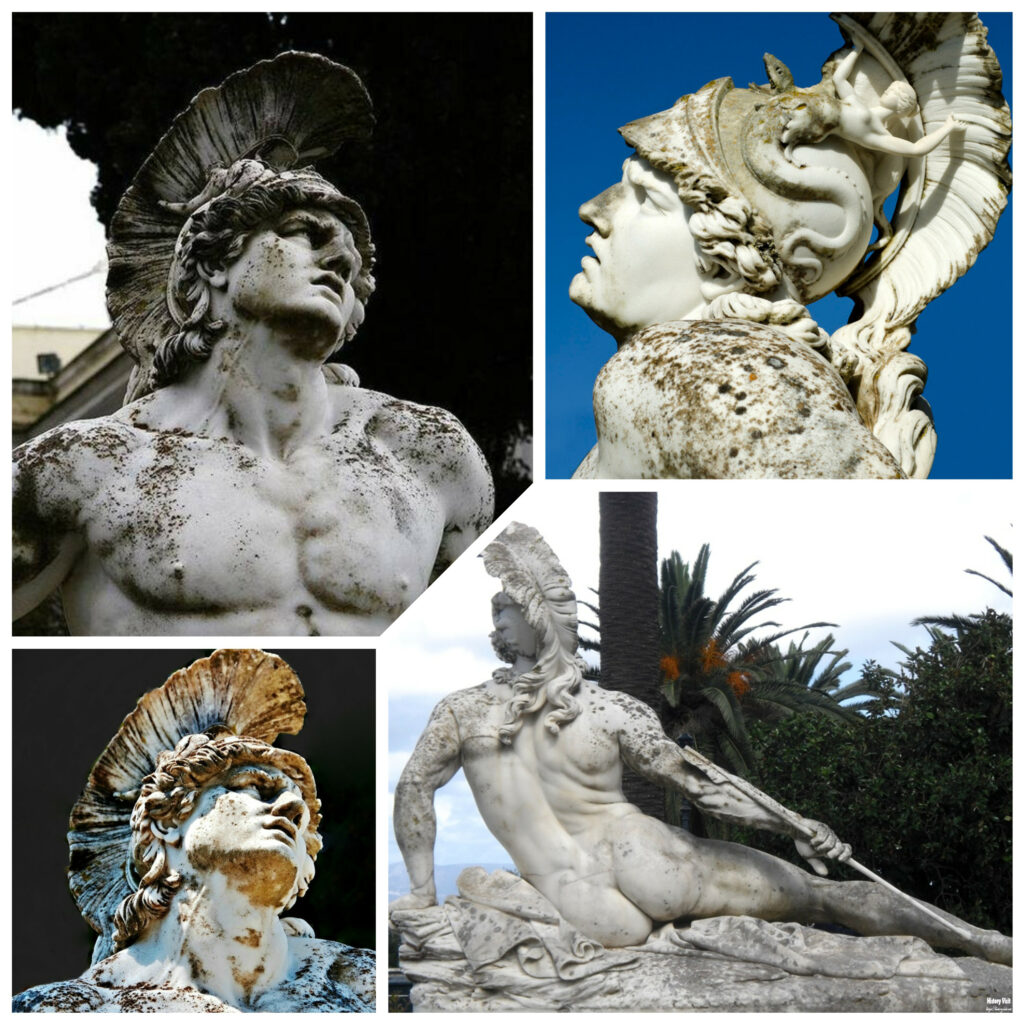
Introduction
The Achilleion Palace, situated on the idyllic island of Corfu, Greece, is a marvel of classical grandeur and romanticism. Built in 1890 by Empress Elisabeth of Austria, popularly known as Sisi, the palace was conceived as a sanctuary dedicated to her passion for Greek mythology. Among the many artistic treasures that adorn the palace, the statue of the Dying Achilles stands out as a particularly evocative and poignant centerpiece. This statue, depicting the legendary Greek hero Achilles in his final moments, captures both the physical prowess and the tragic vulnerability of one of mythology’s most iconic figures.
The statue of the Dying Achilles, crafted by the German sculptor Ernst Gustav Herter in 1884, is more than a mere artistic representation; it is a profound symbol of heroism, beauty, and the inevitability of mortality. Positioned in the palace’s lush gardens, the statue not only enhances the aesthetic appeal of its surroundings but also invites deep contemplation on themes of glory, fate, and human frailty. This article delves into the historical context of Achilleion Palace, the artistic and symbolic features of the Dying Achilles statue, and the enduring legacy of this powerful work of art.
Historical Context of Achilleion Palace
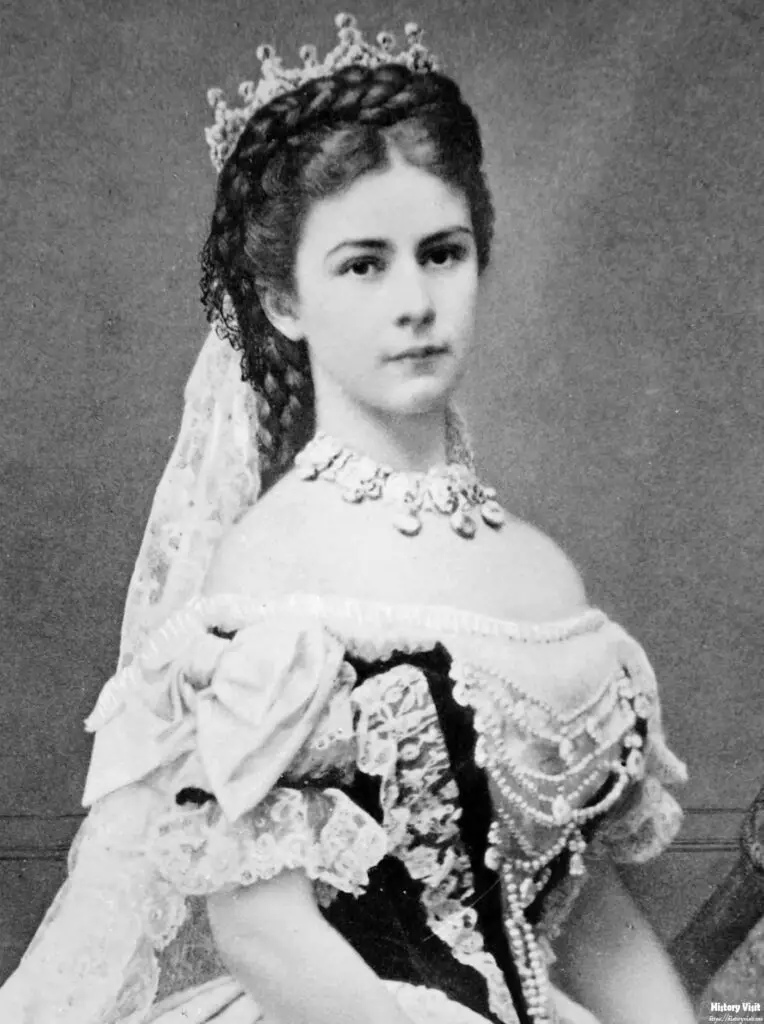
Achilleion Palace was built in 1890 under the direction of Empress Elisabeth of Austria, affectionately known as Sisi. The Empress was known for her deep appreciation of ancient Greek culture and mythology, and she chose to create a palace that reflected her passion. The palace itself is a stunning example of neoclassical architecture, adorned with numerous works of art and design elements that pay homage to the glories of ancient Greece. This dedication to classical themes is evident in every aspect of the palace’s design, from its grand halls to its beautifully landscaped gardens.
The construction of the palace was a labor of love for Empress Sisi, who sought solace in its serene environment following the many personal tragedies she faced. Her admiration for the hero Achilles, in particular, was a driving force behind the palace’s theme. She saw in Achilles a kindred spirit, a figure of immense strength and beauty who was also vulnerable to the caprices of fate. This thematic choice underscored her own existential reflections and her romanticized view of the ancient world.
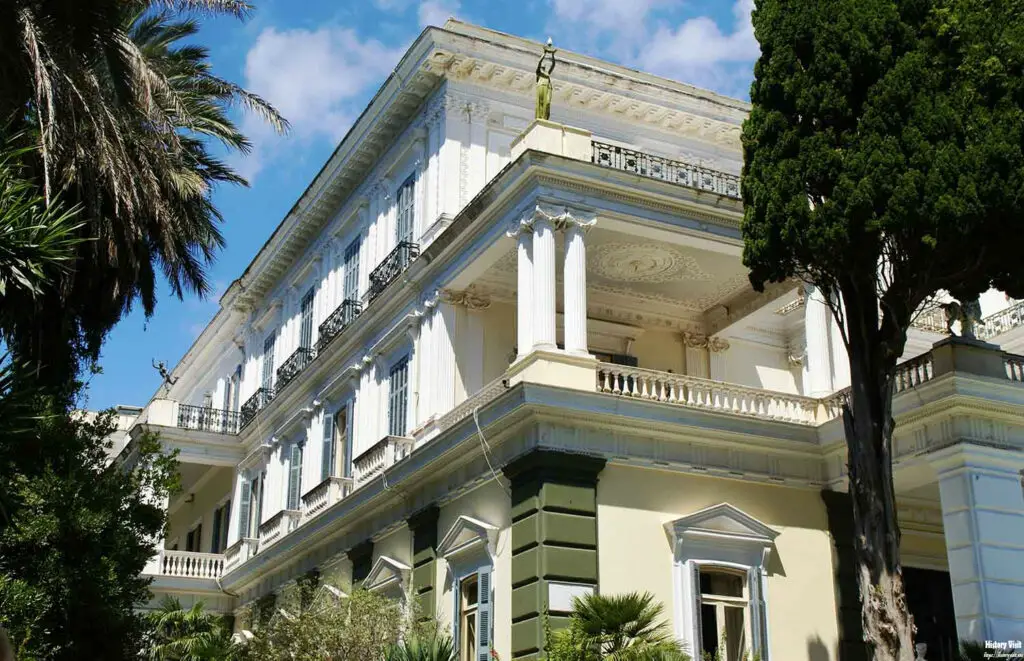
Achilleion was not just a private retreat but also a cultural statement. It became a venue where the classical past was brought vividly to life, intended to inspire and educate visitors about the grandeur of ancient Greece. The palace quickly became a focal point for scholars, artists, and admirers of classical antiquity, solidifying its place as a cultural landmark. Over time, it has remained a symbol of Sisi’s legacy and her enduring fascination with Greek mythology.
Today, Achilleion Palace is a popular tourist attraction, drawing visitors from around the globe who are eager to experience its historical and artistic treasures. It stands as a monument to Empress Sisi’s vision and her deep connection to the classical past, offering a glimpse into the world of myth and history that so captivated her imagination. The palace’s legacy continues to inspire awe and admiration, making it a cherished cultural heritage site.
The Dying Achilles Statue

The statue of the Dying Achilles, created by German sculptor Ernst Gustav Herter in 1884, is the centerpiece of the Achilleion Palace gardens. This masterpiece of classical sculpture captures the essence of Achilles at the most vulnerable moment of his storied life. The statue’s placement in the garden, surrounded by lush greenery and the serene environment of Corfu, adds to its emotional impact. Visitors encountering the statue are immediately struck by its dramatic portrayal of pain and heroism.
Herter’s depiction of Achilles is both powerful and poignant. The statue shows Achilles reclining, his muscular body writhing in agony as he clutches the fatal arrow lodged in his heel. This arrow, shot by the Trojan prince Paris, is a potent symbol of Achilles’ tragic fate, highlighting the hero’s singular vulnerability amidst his otherwise invincible form. The meticulous detail in the sculpture, from the tension in Achilles’ muscles to the intricate design of his armor, demonstrates Herter’s exceptional skill and artistic vision.

The expression on Achilles’ face is a masterpiece of emotional depth. It conveys a mixture of pain, resignation, and perhaps a hint of defiance, capturing the hero’s inner turmoil as he confronts his mortality. This emotional intensity is enhanced by the statue’s lifelike detail, making it seem as though Achilles might at any moment breathe his last. The realism of the sculpture draws viewers into Achilles’ plight, evoking a deep sense of empathy and reflection on the nature of heroism and sacrifice.

Positioned prominently within the palace gardens, the Dying Achilles statue invites contemplation and reverence. It serves as a powerful reminder of the fragility of life and the inevitability of death, themes that resonate deeply with visitors. As they walk through the gardens and encounter this moving depiction of Achilles, they are transported back to the world of ancient Greece, where heroes like Achilles lived and died, leaving behind legacies that continue to inspire.
Artistic and Symbolic Features
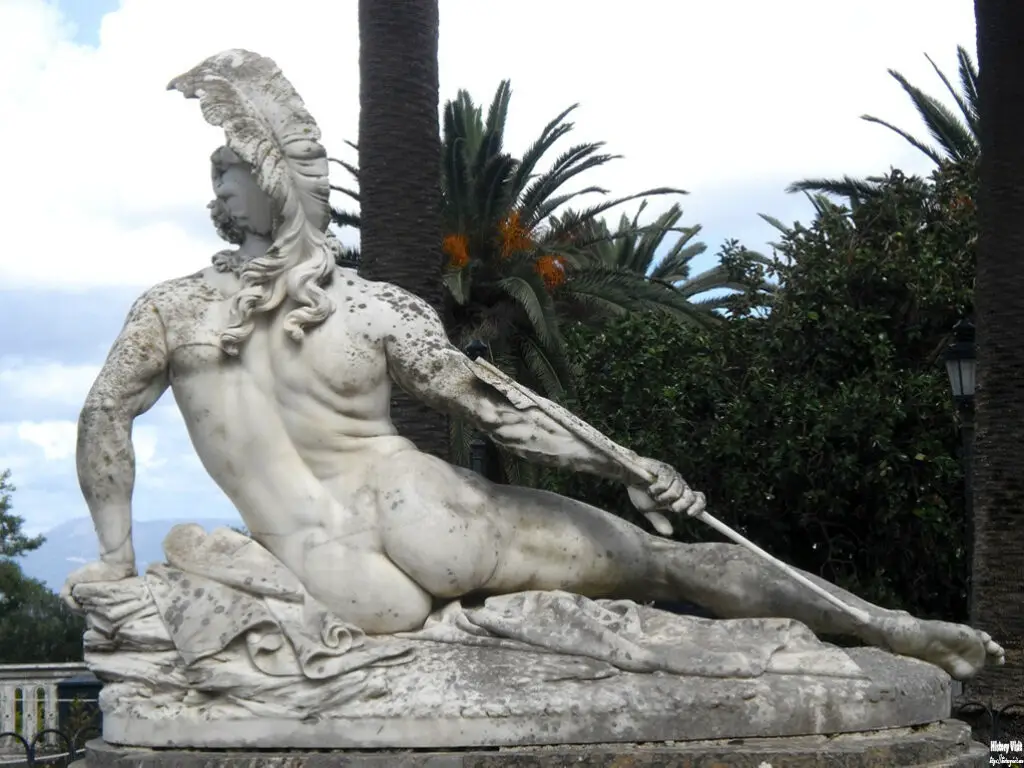
The Dying Achilles statue is a masterclass in sculptural artistry and symbolism. Herter’s work captures the essence of Achilles’ tragic story with a blend of realism and idealism that is characteristic of classical sculpture. The statue’s anatomical precision and the dynamic pose of Achilles reflect the influence of ancient Greek art, while also incorporating a level of emotional expression that speaks to more modern sensibilities. This combination of classical and contemporary elements makes the statue a timeless piece of art.
One of the most striking aspects of the statue is its detailed depiction of Achilles’ physical form. Herter’s meticulous attention to the anatomy of the hero showcases his expertise in capturing the human body in motion. Every muscle and sinew is rendered with precision, conveying the strength and vitality of Achilles even in his dying moments. This focus on physical detail enhances the statue’s realism and helps to convey the hero’s agony and struggle.
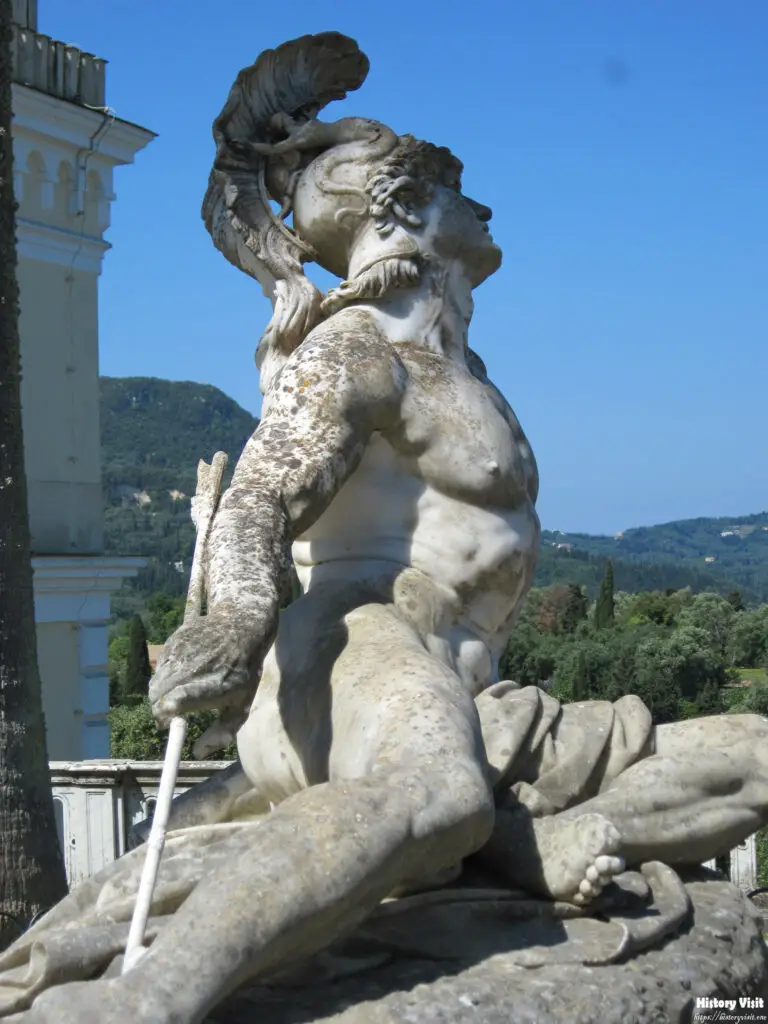
Symbolically, the statue is rich with meaning. The arrow in Achilles’ heel represents not only his death but also the broader themes of vulnerability and fate. Despite his near invincibility, Achilles is brought down by a single, seemingly insignificant weakness. This paradox serves as a powerful reminder of the limitations of human strength and the inevitable nature of mortality. The statue encapsulates the duality of Achilles’ character: a mighty warrior brought low by fate, embodying both the glory and tragedy of the human condition.
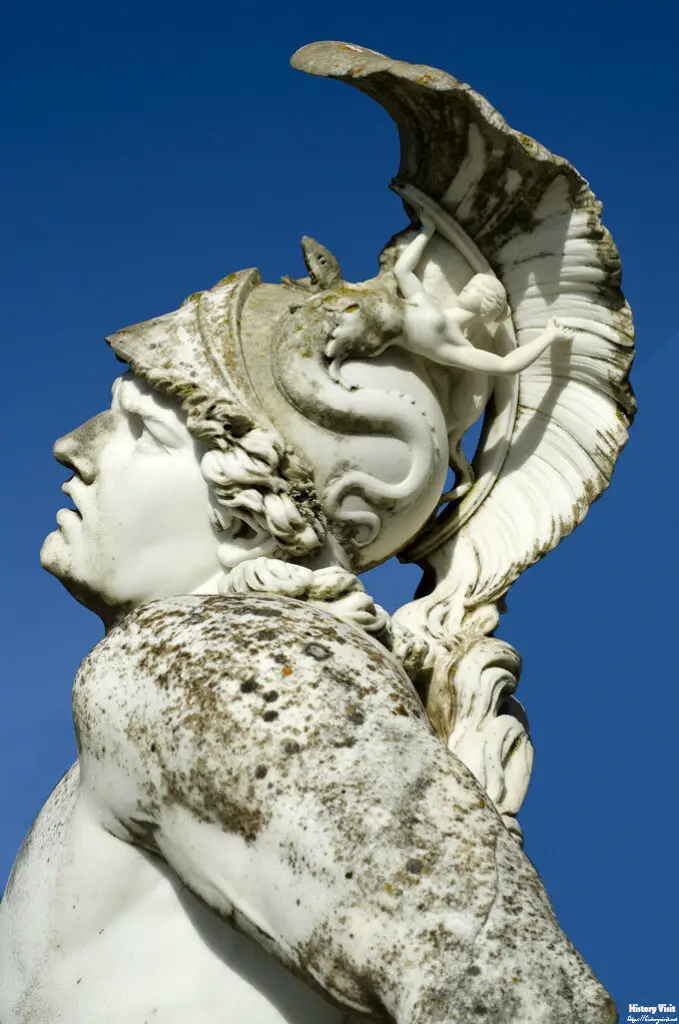
The Dying Achilles also reflects the personal struggles of Empress Sisi herself. Like Achilles, she was a figure of great beauty and strength who faced profound personal sorrows. The statue can be seen as a metaphor for her own life, marked by both public admiration and private grief. This personal connection adds another layer of depth to the statue’s symbolism, making it not just a representation of a mythological hero but also a reflection of Sisi’s own experiences and emotions.
Symbolism and Legacy

The statue of the Dying Achilles serves as a powerful symbol of heroism, beauty, and the tragic nature of human existence. For Empress Sisi, the statue likely represented her own struggles and melancholic outlook on life. Just as Achilles faced his demise despite his greatness, Sisi, too, was no stranger to sorrow and loss, having endured personal tragedies throughout her life. This shared sense of vulnerability and tragic fate creates a poignant connection between the statue and the empress who commissioned it.
Beyond its personal significance to Sisi, the Dying Achilles encapsulates broader themes of glory and mortality. Achilles, who epitomized the warrior ethos and achieved eternal fame, ultimately succumbed to his singular vulnerability. This duality is a reminder of the transient nature of life and the inevitability of death, regardless of one’s might or achievements. The statue thus serves as a reflection on the human condition, where moments of greatness are often intertwined with profound loss.

The enduring legacy of the Dying Achilles statue is evident in its continued ability to captivate and inspire. It stands not only as a piece of art but as a historical and cultural artifact that connects the past with the present. The statue’s timeless themes resonate with viewers from all walks of life, offering insights into the nature of heroism, sacrifice, and the fleeting nature of human existence. This ability to transcend time and culture underscores the universal appeal and significance of Herter’s masterpiece.
Today, the Dying Achilles remains a central attraction at Achilleion Palace, drawing visitors from around the world. Its powerful imagery and emotional depth continue to move and inspire those who encounter it. As a symbol of both ancient myth and personal tragedy, the statue stands as a testament to the enduring power of art to convey profound truths about the human experience. Through its presence in the palace gardens, the Dying Achilles keeps alive the legacy of both the hero it depicts and the empress who honored him with this timeless tribute.
Conclusion

The statue of the Dying Achilles in Achilleion Palace stands as a profound testament to the intersection of art, mythology, and personal narrative. Empress Elisabeth’s choice to center her palace around this poignant depiction of Achilles reflects her own struggles and the timeless human themes of heroism, vulnerability, and mortality. The intricate artistry of Ernst Gustav Herter brings these themes to life, allowing visitors to engage with Achilles’ story on a deeply emotional level. The statue’s detailed realism and expressive power continue to captivate and move all who encounter it.
Today, Achilleion Palace, with the Dying Achilles as its centerpiece, remains a cherished cultural and historical landmark. It serves as a bridge between the past and present, offering insights into the rich tapestry of Greek mythology and the personal reflections of an empress who found solace in its stories. The enduring appeal of the Dying Achilles reminds us of the universal truths embedded in ancient myths, truths that resonate across time and continue to inspire awe and introspection. Through its powerful imagery and symbolic depth, the statue ensures that the legacy of Achilles and the vision of Empress Sisi live on, captivating the hearts and minds of visitors from around the world.


